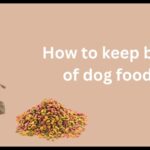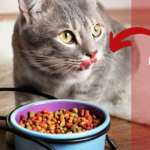Are you worried about how to Measure Dog Food portions? Almost every dog owner is puzzled with this question right now.
Don’t worry!!! In this article, we will explore the process of measuring dog food portions and provide practical tips for accuracy.
We will discuss factors such as breed and activity level that affect how much food your dog needs.
Learn how to measure your dog’s food portions. It is crucial for their health and to prevent problems like obesity or malnutrition.
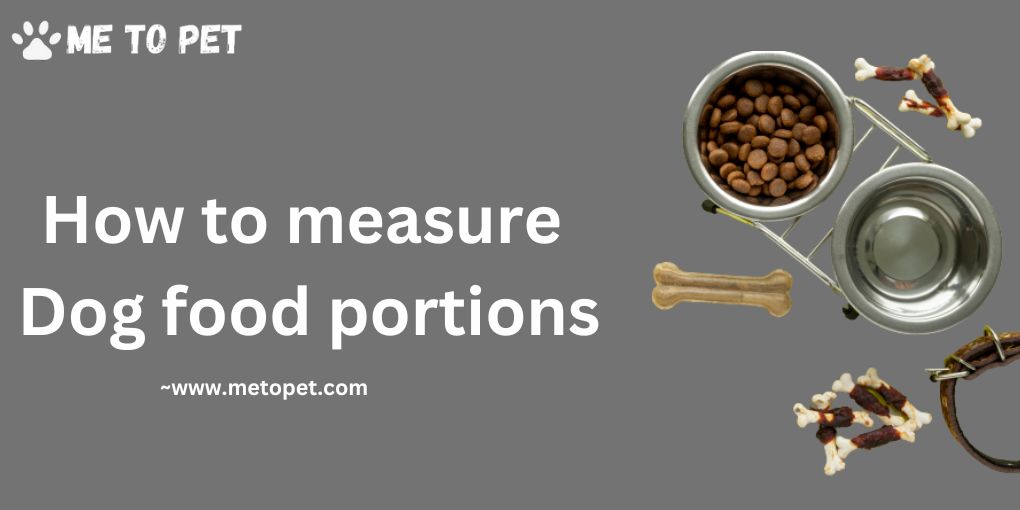
Giving your dog the right amount of food ensures they get the right nutrition and maintain a healthy weight.
Many dogs struggle with weight issues. In the United States, for example, about 56% of dogs are overweight or obese. This worrying statistic highlights the importance of paying attention to your dog’s food portions.
By the end of this article, you will clearly understand how to measure your dog’s food portions. This will enhance their overall health and well-being.
What Types Of Food Dog Needed
Providing a well-rounded diet for your canine companion is vital to their health and vitality. Dogs, like humans, must have a balanced and nutritious diet to thrive. Understanding the types of food that contribute to their well-being is essential. Here are some key food items and categories that are beneficial for dogs:
Protein-Rich Foods:
Dogs are naturally carnivorous, so protein is a crucial component of their diet. When selecting meats, choose low-fat options like chicken, turkey, beef, and fish. These protein sources supply essential amino acids necessary for muscle development.
Fruits And Vegetables:
Certain fruits and vegetables offer dogs valuable vitamins, minerals, and antioxidants. Using them as healthy treats consider incorporating fruits like apples that spinach meals
Whole Grains:
Brown rice, quinoa, and oats are excellent sources of carbohydrates and fiber because they are whole grains. They provide energy and support healthy digestion. Remember, some dogs may have grain allergies or sensitivities. So if you have concerns, consult a veterinarian.
Dairy Products:
While not all dogs can tolerate dairy, some can enjoy plain yogurt or cottage cheese. These options offer protein and calcium. Ensure your dog isn’t lactose intolerant before introducing dairy products into their diet.
Healthy Fats:
The role of omega-3 fatty acids is crucial in promoting healthy skin, coat, and immune systems for dogs. Consider including sources like fish oil, flaxseed, or coconut oil in their diet.
Here Are Some Specific Food Items For Dogs
- Purina Pro Plan
- Hill’s Science Diet
- Royal Canin
- Iams
How Do You Measure Dog Food Portions?
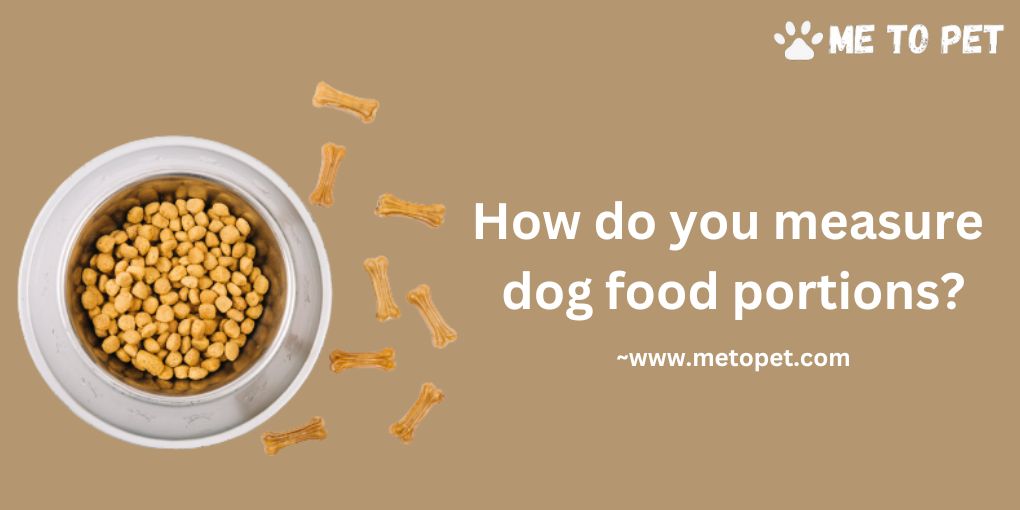
Measuring your dog’s food portions is important to make sure they get the right amount of nutrition. Here are some easy tips to help you measure their food correctly:
Use A Measuring cup:
Get a special measuring cup for pet food. They come in different sizes and can help you give the exact amount of food your dog needs. Measuring cup pet food based on their size and weight.
Follow Feeding Guidelines:
Most dog food brands provide guidelines on the package or their website. These guidelines suggest sizes based on your dog’s weight. Start with these recommendations and adjust as needed based on your dog’s activity level and metabolism.
Consider Age And Stage:
It’s important to note that puppies and adult dogs require different types of nutrition. Make sure to give the right size based on your dog’s age to support their growth and development.
Watch Their Body Condition:
Keeping track of your dog’s weight and overall body condition is essential. You can use a chart from a vet or ask a professional to assess if your dog is underweight, overweight, or just right. Adjust the food portions accordingly to keep them at a healthy weight.
Avoid Leaving Food Out All The Time:
To prevent overeating, it’s advisable not to keep food accessible at all times. Instead, establish set meal times and serve measured portions. This helps control their intake and prevents excessive snacking.
N.B: It’s important to remember that these are general guidelines, and individual dogs may have unique nutritional needs. Consulting with a veterinarian or professional pet nutritionist can provide personalized guidance. Veterans can ensure that your dog’s specific conditions are met.
The Size Of Your Dog’s Meal Portion Is Influenced By Various Factors.
The size of your dog’s meal portion is influenced by various factors. Much like humans, dogs have unique nutritional requirements that depend on their activity level, and health. Figuring out the appropriate amount of food for your canine companion can be daunting. But it is vital for their overall well-being and to prevent weight-related problems. We have created a helpful table below, which presents the recommended total daily food intake based on your dog’s weight.
In general, the following guidelines provide total daily food amounts for dogs based on their weight:
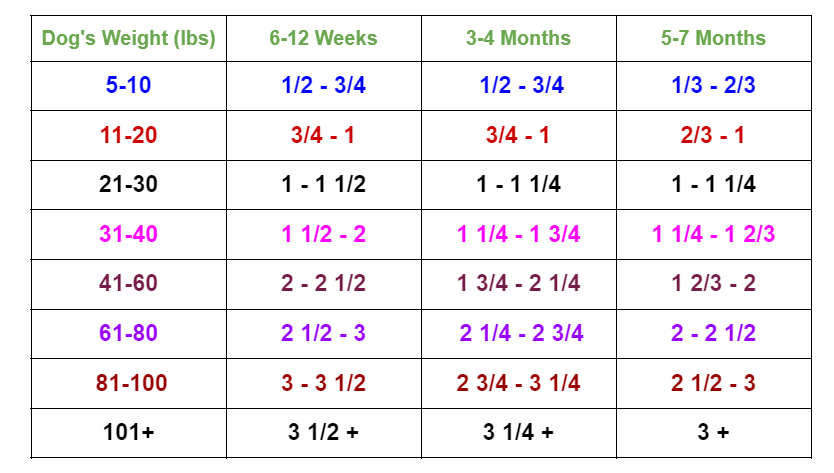
How often should you feed your dog

Determining the frequency of feeding for your dog involves considering several important factors:
Age:
Puppies have higher nutritional needs and require more frequent meals compared to adult dogs. Puppies should be fed 3-4 times a day during their early stages and transitioned to twice-daily feedings around 5-6 months of age.
Size:
The size of your dog also influences its feeding schedule. Smaller dogs benefit from more frequent meals, such as three times a day, whereas larger breeds often do well with just two meals.
Activity level:
Dogs with higher activity levels may benefit from smaller, more frequent meals throughout the day. On the other hand, less active dogs can generally thrive on two meals per day.
Health:
Certain health conditions, such as digestive issues, may require more frequent small meals. It’s advisable to consult your veterinarian. Who can recommend a suitable feeding schedule based on your dog’s specific needs?
Type of food:
Different types of food have varying perishability. Wet food and higher moisture content should be included for extended periods. They are often served in 2-3 smaller meals. Dry kibble, which is less perishable, can be left out for longer and is suitable for two meals per day.
In general, feeding adult dogs twice a day is a commonly recommended practice. It would help if you aimed to have one meal in the morning and one in the evening. The amount of food required depends on your dog’s individual calorie needs. This can be determined by weight, age, and lifestyle factors. Your veterinarian is the best person to help you choose the appropriate portion sizes for your dog.
Most adult dogs thrive on twice-daily feedings, while smaller or more active dogs may benefit from three meals a day. Especially when young, puppies should be fed 3-4 times daily.
Conclusion:
Measuring dog food correctly is important for keeping your dog healthy. Use a measuring cup or scale, follow the directions on the food bag for how to measure dog food portions.
Watch your dog’s weight and body the first weeks, giving a little more or less food if needed.
You can check your dog monthly by feeling the ribs and spine. Change the food amount a little each time based on your dog’s appearance.
Listen to the vet too at checkups each year. Keep measuring the food and checking your dog. This helps your dog stay a good weight for a long time. Measuring the food right takes work and patience.

Patricia White is a pet enthusiast. With 10 years of experience in the pet industry, she brings a wealth of knowledge and expertise to MeToPet. She is honored to be a part of the MTP team and is dedicated to sharing her passion for pets with our readers.



